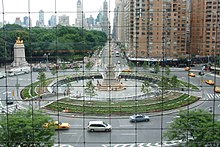Columbus Circle
The circle is the point from which official highway distances from New York City are measured, as well as the center of the 25 miles (40 km) restricted-travel area for C-2 visa holders.
Hell's Kitchen, also known as Clinton, is located to the southwest, and the Theater District is to the southeast and the Lincoln Square section of the Upper West Side is to the northwest.
[23] The circle was altered in 1905 by William Phelps Eno, a businessman who pioneered many early innovations in road safety and traffic control.
[24][25] In a 1920 book, Eno writes that prior to the implementation of his plan, traffic went around the circle in both directions, causing accidents almost daily.
A New York Times article in June 1929 stated that the "Christopher Columbus [monument] is safe and serene, but he's the only thing in the Circle that is.
In 1941, engineers with the New York City Parks Department and the Manhattan Borough President's office formed a tentative agreement to redesign Columbus Circle yet again.
[32][33] Through north–south traffic on Broadway, Eighth Avenue, and Central Park West would use two 71-foot-wide (22 m) divided roadways with 5-foot-wide (1.5 m) landscaped medians, running in chords on either side of the Columbus monument.
[36] However, the plan still had some issues, the largest of which was that traffic traveling on Broadway in either direction would be routed onto Eighth Avenue or Central Park West, and vice versa.
A new northbound roadway was cut through the southern tip of the center traffic island that contained the statue, from Eighth Avenue to the eastern chord.
In 1979, noted architecture critic Paul Goldberger said that the intersection was "a chaotic jumble of streets that can be crossed in about 50 different ways—all of them wrong.
"[28] In 1987, the city awarded a $20 million contract to Olin Partnership and Vollmer Associates to create a new design for the circle.
[28][42] The fountain, the main part of the reconstructed circle, contains 99 jets that periodically change in force and speed, with effects ranging between "swollen river, a rushing brook, a driving rain or a gentle shower".
[57][60] The construction project, in turn, was the culmination of an effort to remove San Juan Hill, the slum that had been located at the site.
[61] Until the Jacob K. Javits Convention Center was built in Hell's Kitchen in the 1980s, the Coliseum was the primary event venue for New York City.
The USS Maine monument was designed by Harold Van Buren Magonigle and sculpted by Attilio Piccirilli, who did the colossal group and figures, and Charles Keck, who was responsible for the "In Memoriam" plaque.
[52][83] The statue is a memorial to sailors killed aboard the battleship USS Maine, whose mysterious 1898 explosion in Havana harbor precipitated the Spanish–American War.
It was replaced by 2 Columbus Circle, an International Modernist tower designed by architect Edward Durrell Stone to house the Huntington Hartford Gallery of Modern Art.
[64][87][88] Its radical transformation was controversial for the failure of the city's Landmarks Preservation Commission to hold hearings on its worthiness for designation.
[92] 240 Central Park South, a balconied moderne apartment building across Broadway from the museum, is directly on the southeast corner of the circle.
[93] Built between 1939 and 1940 to designs by Albert Mayer and Julian Whittlesey,[93][92] it is a city-designated landmark and a National Registered Historic Place.
[100] The facade has a bust of the English painter Thomas Gainsborough, a bas-relief by Isidore Konti, and tile murals by Henry Chapman Mercer.
[105] On 58th Street, east of 220 Central Park South, are two New York City designated landmarks: the Helen Miller Gould Stable and the firehouse of Engine Company 23.
[92] The four-story horse stable, at 213 West 58th Street, was designed by York and Sawyer in the French Renaissance style for wealthy philanthropist Helen Miller Gould.
[108]: 1 The adjoining firehouse of Engine Company 23, at 215 West 58th Street, was designed by Alexander H. Stevens (the New York City Fire Department's superintendent of buildings[108]: 3 ) in the Beaux-Arts style.
[111] 4 Columbus Circle, an eight-story low-rise located at 989 Eighth Avenue at the southwest corner of the intersection with 58th Street, was built in the late 1980s.
[138] The travel area for recipients of a C-2 visa, which is issued for the purpose of immediate and continuous transit to or from the headquarters of the United Nations, is limited to a 25-mile radius of Columbus Circle.
[140][141][142][143] The New York City government employee handbook considers a trip beyond a 75-mile radius from Columbus Circle as long-distance travel.
[148] The area sometimes had a poor reputation for cranks and street preachers, the "lunatic fringe whose tub-thumping make a nightmare of Columbus Circle" condemned by a New York Court of Appeals ruling in a case related to elsewhere in the city,[149] that prompted mid-20th century configurations,[35] but was also sometimes showcased by the national government as a rambunctious symbol of American freedom of speech.
[152] The USS Maine Memorial, was featured in the 1976 movie Taxi Driver, where Robert De Niro's character was thwarted in an attempt to assassinate a presidential nominee.
[153] Columbus Circle was featured in the 1984 movie Ghostbusters as the place where the Stay Puft Marshmallow Man manifests and then walks up Central Park West.





